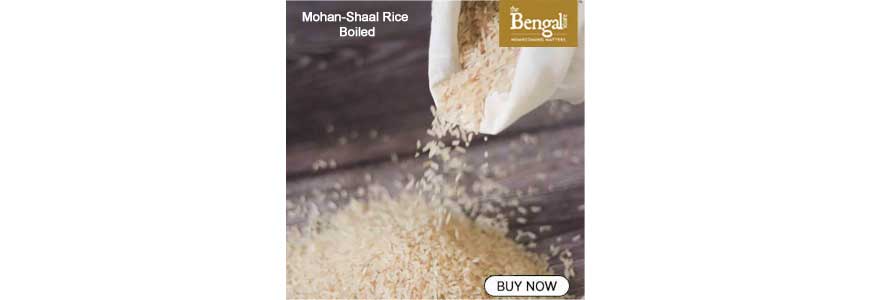Searsloe and Ukhra Ratha Yatra: Legacy of celebrating the glory of the Supreme Lord
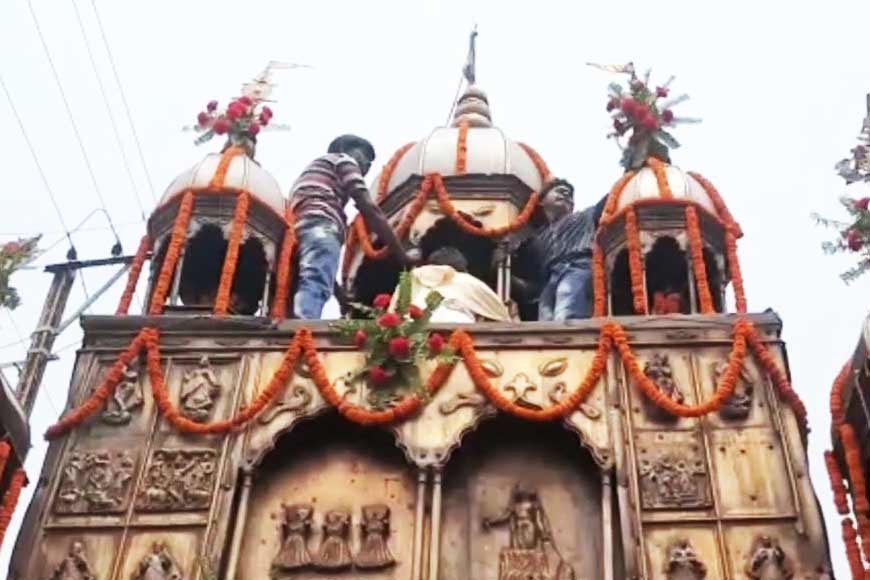
Raniganj is a mining town in the Asansol subdivision of West Burdwan district. According to the Burdwan Register, this region was once a dense forest where wildlife flourished. The town came into prominence when coalmining in India first started here in 1774. The Raniganj coal mine, which provided 88% of the country’s coal in the 19th century was once the hub of activities drawing the attention of fortune seekers from far and wide. But now the town has lost its luster and its glorious days have been relegated to the pages of history. However, heritage still reigns here, and two illustrious families, the Mallyas of Searsole Rajbari (Palace) and Handas of Ukhra are a living testimony of Raniganj’s grandeour during its heyday.
During the annual Ratha yatra, Searsole Rajbari and its sleepy neighbourhood wake up to celebrate the festival with gusto. The area reverberates with music, dance and festivities. A fortnight-long fair is held on the large ground close to the palace. The ratha or chariot is taken out for the ceremonial journey of Jagannath, Balaram and Subhadra along with the Kuladevta (patron deity) of the royal family, Damodar Chandra Jiu, seated at the top of the chariot. The brass chariot at Searsole Rajbari is the third largest ratha of Jagannath Dev in India. In fact, the historical ratha yatra held at Searsole and Ukhara can stake a claim to the annual heritage Ratha Yatras held at Mahesh, Guptipara, Mahishadal, Bankati, Hetampur and Dasghara.
Govindaprasad Pandit was the founder of Searsole dynasty. He accompanied his father, Sadashiv Pandit, to Bengal from the Punjab province. They belonged to a Saraswat Brahmin family of Punjab. Govindaprasad worked as a clerk in the coal mines of Mr. Alexander at Raniganj. Later he joined the East India company and was appointed Deputy Collector of 24 Parganas and Srihatta (Sylhet). He was a relative of Shambhunath Pandit, the first indigenous judge of the Calcutta High Court (1863). Govindaprasad travelled extensively to different parts of Bengal and acquired experience as an administrator. He had strong business acumen and he honed his skills while working as a Collector. His childhood was spent in Bankura but he shifted base and settled in Egara village near Raniganj.
Once he settled at Searsole, Govindaprasad bought the zamindari (ownership) of Searsole and other neighbouring villages like Jamihari. This was the prime time for the coal mining industry in the area and Govindaprasad utilized the opportunity to the hilt. He set up his sprawling residence at Searsole, which later came to be known as the ‘Purono Rajbari’ (the old palace). This palace is now in ruins.
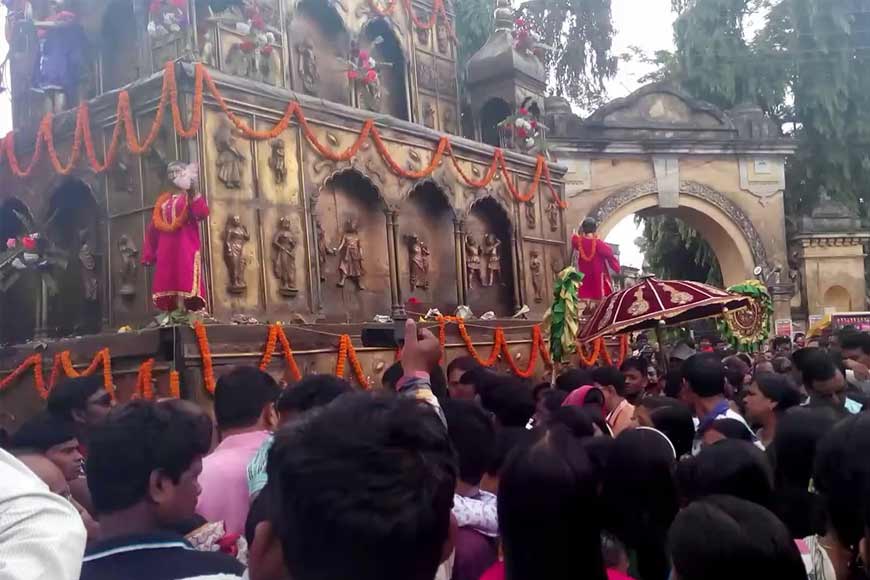
Govindaprasad was hard-working and an astute man who exploited the underground coal resources here and amassed vast wealth and ensured prosperity for later generations as well. Also a philanthropist, he invested liberally in the growth and development of the neighbourhood villages. He founded the Searsole Raj School in 1856 where rebel poet, Kazi Nazrul Islam was a student. He also set up Chatushpathi (or ‘tol,' that were institutes for studying classical Sanskrit literary works), constructed metalled roads, digging reservoirs for drinking water etc. Govindaprasad and his family contributed immensely to enrich the local cultural environment. Govindaprasad was a pious man and a devotee of Narayana. He established the Narayanasila (a particular variety of stone collected from riverbed or banks of rivers and used as a non-anthropomorphic representation of Vishnu by Hindus ) of the family deity of Damodarchandra Jiu.
Rath Festival at Ukhra: Situated between Damodar and Ajay Rivers, Ukhra in the Andal CD block in Durgapur subdivision of West Burdwan district, is renowned for its annual chariot festival that was initiated by the Handa family. The history of Handa family goes back to the year 1632 AD when Keval Ram Handa travelled all the way from Machchhihatta area of Lahore to Murshidabad looking for business opportunities and settled down there seeing good prosperity.
Govindaprasad passed away on 16 Poush, 1268 (according to Bengali calendar), that is, 1868 AD. Before his death, he bequeathed his entire property to the service of the family deity and made it mandatory for the most competent member of the clan to take charge of all the rituals and serve the revered deity and take care and serve the family. He also left clear instruction that since he could not beget a male heir, his widow, Darimba Devi could adopt a male child to continue the family line.
Govindaprasad Pandit and his wife had four daughters, namely Shyamasundari, Harasundari, Satyabhama and Uttamkumari. Their second daughter, Harasundari, was married to Motilal, son of Rasiklal Mallya, a resident of Singur in Hooghly district. Harsundari was the only one among Govindaprasad's four daughters who had five sons and one daughter. Darimba Devi was very fond of her grandsons and hence did not go for adoption. The vast wealth left behind by Govindaprasad was further augmented by the joint efforts of Darimba Devi and her eldest grandson, Vishvesvara. At one point, the annual income of the estate reached a whooping Rs.5 lakhs! Darimba Devi passed away in 1872 AD. After her demise, the entire property and wealth of Govindaprasad Pandit’s family got transferred to Mallya family.
Bengal was hit by a great famine during the reign of Lord Northbrook, who was the Viceroy of India from 1872 to 1876. Harsundari and her son Vishvesvara resorted to an extensive relief effort to alleviate the condition of the affected people. In recognition of their philanthropy, Harasundari was conferred the title of 'Queen' and Vishvesvara was honoured with the tiltle of 'King' by the English Parliament in 1872. Since then, the wealthy family of Searsole was recognized as a royal family. On January 1, 1877, Queen Victoria was proclaimed the ‘Empress of India’ and on that occasion, Lord Lytton conferred the title of 'Maharani' on Harasundari and 'Rajbahadur' on Vishvesvara.
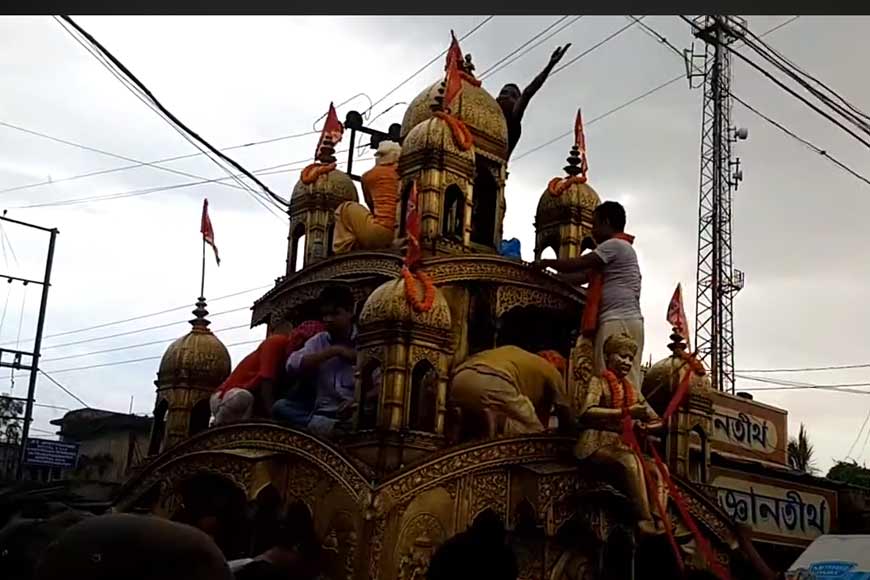
According to local sources, in the same year, that is, 1877, Maharani Harasundari Devi and Rajbahadur Vishvesvara commenced the chariot festival at Searsole. Initially, the chariot was made of wood but half-a-century later, the chariot was gutted in a devastating fire. Rajbahadur Vishvesvara’s son, Pramathanath Mallya replaced the wooden carriage with a beautiful brass chariot.
The nine-spiralled chariot is possibly the highest among similar brass creations. Thirty feet high and 16 ft 3 inches in length and width, the chariot is three-storied. There is an entrance in the front on the first floor. A flight of stairs inside leads to the other two floors above. The chariot is built following the classical terracotta Navaratna temple style architecture of Bengal with nine towers. The structures contain gabled roofs which are colloquially called the chala. The entire exterior of the chariot is intricately decorated with episodes from the Ramayana, Mahabharata, Puranas and Krishna Leela. Notable carvings include idols of Annapurna, Vishnu, Kali, Simhavahini, Sita-harana, Radha-Krishna, Jagai-Madhai, Gaur-Nitai, Vishnu's Dashavatar forms, Rama-Sita-Dashanan, Jagannath-Balaram-Subhadra, Dakshina Kali, slaughter of Bakasura, Kaliya Daman and also scenes of nouveau riche Babus and European ladies. There are a total of 36 pairs of peacocks and eyes around the chariot. The idols of Lord Jagannath, -Balaram and Subhadra are permanently mounted on the chariot. On the day of Rath Yatra, two horses, the charioteer and the doorman are placed at the front of the chariot.
Also read : Silver Rath of Murshidabad 250-year-old
The central deity of Searsol chariot fesatival is not Lord Jagannath. Although He is there, on the occasion of Ratha Yatra, the family’s deity (Kula-devata), Lord Damodar Chandrajiu is brought from the inner sanctum of the temple and placed on the top tier of the chariot. Following tradition, the chariot journey here starts in the morning from the new Rajbari. It rolls till the old Rajbari complex where the journey terminates symbolically. The heavy brass chariot is pulled by a truck. In the evening, the ritual of the ‘Ulto Rath’ or the chariot’s journey back takes place on the same day. The chariot remains static in front of the new palace for the rest of the year.
The chariot festival is a major draw and people from all walks of life and from different parts of the state as well as adjoining Jharkhand state gather here in large numbers to participate in the revelry. Although the chariot belongs to the Mallya family, its upkeep is undertaken by members of the local 'Searsole Sports and Cultural Association' who also organize the annual Ratha Yatra and the fair held at the site. Time has taken its toll and several portions of the brass chariot shows signs of ageing. Signs of wear and tear are evident, especially in the lower deck of the chariot. Some portions have disintegrated and several idols have gone missing. The chariot needs complete overhauling.
Rath Festival at Ukhra: Situated between Damodar and Ajay Rivers, Ukhra in the Andal CD block in Durgapur subdivision of West Burdwan district, is renowned for its annual chariot festival that was initiated by the Handa family. The history of Handa family goes back to the year 1632 AD when Keval Ram Handa travelled all the way from Machchhihatta area of Lahore to Murshidabad looking for business opportunities and settled down there seeing good prosperity. His son, Ram Chandra Handa got married to Ghanshyam Kapoor's daughter, who hailed from the extended Burdwan Raj family. The couple’s only son, Meru Chandra Handa was appointed as Dewan during Alivardi Khan's rule and he flourished considerably. But due to some unforeseen circumstances, Meru Chandra shifted to Shergarh (currently Ukhra) with his family including wife, son (Bakhtar Singh Handa) and daughter (Vishnu Kumari). Since then, the Handa family made Ukhra their new home and has been living there for 12 generations. Vishnu Kumari was married to the then-King of Burdwan, Sri Trilokchand Kapoor. The famous 108 Shiv Temples was later constructed by Vishnu Kumari.
The close affinity with the Burdwan Raj family helped the Handa family prosper and the decedents acquired a large zamidari and also flourished in business, mainly coal mining. The family was conferred the Lall Singha title, and since then, the members are popularly referred to as the Lall Singha family of Ukhra in the whole coal belt. Pulin Behary, a member of the Handa family, was honoured with the Rai Bahadur title during British Rule.
During the annual Ratha yatra, Searsole Rajbari and its sleepy neighbourhood wake up to celebrate the festival with gusto. The area reverberates with music, dance and festivities. A fortnight-long fair is held on the large ground close to the palace. The ratha or chariot is taken out for the ceremonial journey of Jagannath, Balaram and Subhadra along with the Kuladevta (patron deity) of the royal family, Damodar Chandra Jiu, seated at the top of the chariot. The brass chariot at Searsole Rajbari is the third largest ratha of Jagannath Dev in India. In fact, the historical ratha yatra held at Searsole and Ukhara can stake a claim to the annual heritage Ratha Yatras.
In 1739 AD, Meru Chandra constructed a Ram Sita and Damodar Jiu temple. Later, Meru Chandra’s son, Bakhtar Singh brought Gopinath Jiu’s idol from Daihat and established at Ukhra. Since then, Ukhra is also known as Gopinath Thakur Bari. Bakhtar Singh had six sons and among them, Sambhu Nath Lall Handa Handa started the famous Durga Puja at Ukhra which is performed with great pomp and show even today. Some of the other major festivals include Ratha Yatra, Jhulan, Gosto and Rash Utsav.
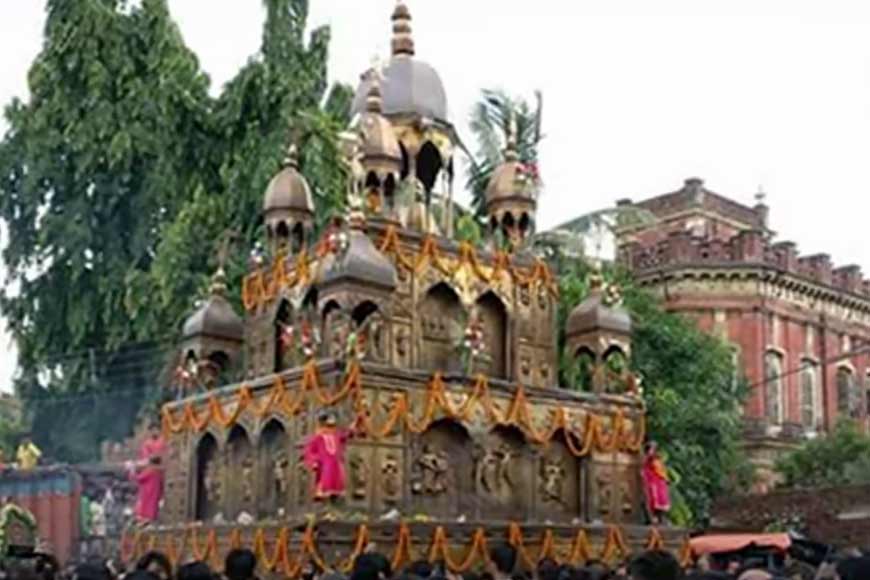
Sambhu Nath started the Ratha Yatra festival in 1871. The 25 ft high chariot is built like a Navaratna Temple. It is 18 ft wide and 12 ft long. The front portion of the chariot is decorated with geometric patterns and sculpted figures of Radha Krishna adorn the walls. There is a plaque in front of the chariot with the words, ‘Om, Sri Sri Gopinath Jeu Rath, Ukhra’ inscribed on it. The historical details of the festival are all inscribed. Ram Gopal Sen, the artisan who built the original wooden chariot , is also mentioned. Radhaballav Mehotori Karmakar later made the brass chariot. The plaque was later inscribed and placed by Radhaballav’s grandson, Asish Mehotori Karmakar. The Handa family has two chariots. During festivals, Gopinath Jeu and Radharani ascend on the larger chariot. There was a time when Gopal Jiu would be mounted on the smaller chariot and taken out during the procession. But this created major problems later and moving with two chariots amid a massive crowd became so difficult that the smaller chariot had to be stationed at one spot. The daily worship rituals are carried on in the small chariot.
On the day of the festival, a special worship of the ratha is held in the morning at the Durga Temple, also known as Chandni Bari. This ritual is known as Punnaho. On this same day, the making of the Durga idol begins with a symbolic layering of clay on the wooden structure of the idol. In the past, all the idols of the Gopinath Temple remained in the open Durga Temple complex for the nine days till the chariot returned but owing to security reasons, this tradition has been discontinued. Nowadays, the chariot’s return journey is held on the same day. In the past, countless people rushed to pull the rope attached to the chariot but for the past 15 years or so, it is pulled with the help of a truck. Devotees hold on to the rope as a symbolic gesture. A fair is held on the nearby ground which is attended by thousands of people from near and far. As the annual chariot festival knocks at the door, there is a flurry of activities in both Searsole and Ukhra and the families gear up to continue their respective ancient family tradition once more.








